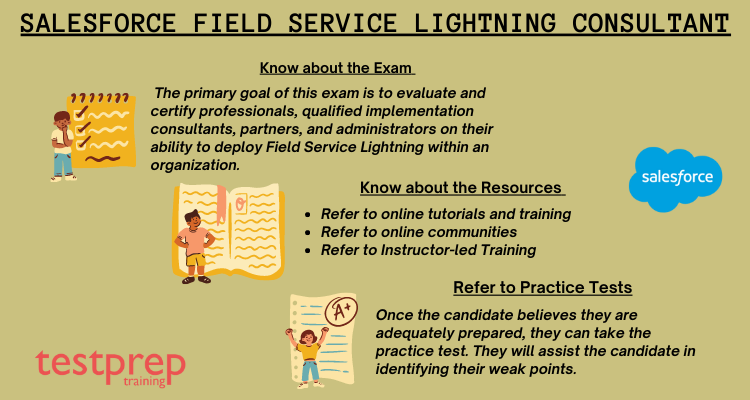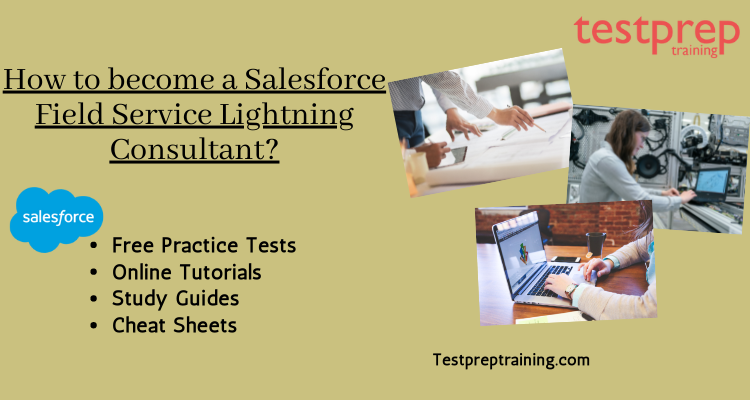The Salesforce Certified Field Service Lightning Consultant program validates qualified implementation consultants, partners, and administrators’ ability to deploy Field Service Lightning to an organization. The course is intended for consultants who have prior experience with Salesforce Service Cloud and Field Service Lightning implementations.
After passing the Salesforce Certified Field Service Lightning exam, you will be able to design and deploy solutions that support customer business processes and requirements using the Field Service Lightning product, managed package, and Field Service Lightning Mobile application.
Let us begin looking at some of the important details and learning resources for Salesforce Field Service Lightning Consultant!
Salesforce Field Service Lightning Consultant Exam
The Salesforce Field Service Lightning Consultant Exam contributes to the Salesforce Certified Field Service Lightning community’s quality and consistency in skills and knowledge. Furthermore, the primary goal of this exam is to evaluate and certify professionals, qualified implementation consultants, partners, and administrators on their ability to deploy Field Service Lightning within an organization.
Who should take the exam?
The Salesforce Field Service Lightning Consultant exam is designed for consultants who have worked on Salesforce Service Cloud and Field Service Lightning implementations. As a Consultant, you will also be responsible for designing and deploying solutions that support customer business processes and requirements using the Field Service Lightning product.
You will also be in charge of managing packages and the Field Service Lightning Mobile application. Furthermore, as a Field Service Lightning consultant, you should have experience in the field service industry, knowledge of mobile solutions, and a strong understanding of the Salesforce core object model. Salesforce Certified Field Service Lightning Consultants must have the following qualifications:
- 1-2 years as a business analyst
- 1+ years in the field services industry
- 2+ years of services and support experience
Let us now jump to the main point of the article!
How to become a Salesforce Field Service Lightning Consultant?
This course is not for everyone. However, you must practice and work hard to achieve this. To help you focus your efforts on the right study resources, we’ve compiled some steps that will aid you in your preparation –

Step 1 – Know in-depth about the exam syllabus
The exam course outline is used to create all of the Salesforce Field Service Lightning Consultant Exam Questions. To ace, the exam, familiarise yourself with the exam concepts. This exam covers the following domains:
1. Managing Resources: 16%
- Compare dynamic versus static crews. (Salesforce Documentation: Create Service Crews
- Determine how and when to set up different resource types. (Salesforce Documentation: Create Service Resources for Field Service)
- also, Given a scenario, recommend the appropriate Service Territories and their Members. (Salesforce Documentation: Create Service Territories for Field Service)
- furthermore, Explain the relationships between timesheets, timesheet entries, service resources, and Work Orders. (Salesforce Documentation: Create Time Sheet Templates, Time Sheet Fields, Guidelines for Creating Work Orders for Field Service)
- moreover, Demonstrate how to use skills, skill levels, and time-based skills. (Salesforce Documentation: Guidelines for Creating Skills for Field Service)
- also, Show how to use operating hours for service resources, accounts, work orders, and booking appointments. (Salesforce Documentation: Guidelines for Creating Operating Hours for Field Service)
- Distinguish between FSL license types and when to deploy them. (Salesforce Documentation: Manage Field Service Permissions)
2. Managing Work Orders: 23%
- Configure Work Order processes, parameters, and Work Types. (Salesforce Documentation: Customize Work Order Settings for Field Service, Create Work Types for Field Service)
- also, Given a scenario, choose the appropriate Resource Preferences. (Salesforce Documentation: Add Service Resource Preferences to Accounts or Work Orders for Field Service)
- furthermore, Apply Products Required to a Work Order. (Salesforce Documentation: Create Work Orders for Field Service)
- moreover, Analyze how and when to use Work Order Line Items. (Salesforce Documentation: Guidelines for Creating Work Orders for Field Service)
- also, Illustrate how to configure Work Order Milestones. (Salesforce Documentation: Set Up the Milestone Tracker, Set Up Milestones)
- furthermore, Given a scenario, recommend the appropriate relationship between Service Appointments, Work Orders, and Work Order Line Items. (Salesforce Documentation: Work Order Line Item Fields for Field Service, Create Service Appointments for Field Service)
3. Managing Scheduling and Optimization: 28%
- Understand different field service settings for FSL Administrator. (Salesforce Documentation: Assign Field Service Permissions)
- also, Given a scenario, choose the appropriate action to manage a Service Appointment. (Salesforce Documentation: Customize Appointment Booking Settings, Manage Service Appointments)
- furthermore, Given a scenario, apply the appropriate life cycle of a Service Appointment required to execute a Work Order. (Salesforce Documentation: Guidelines for Creating Service Appointments for Field Service, Customize the Service Appointment Life Cycle)
- moreover, Decide on the appropriate Schedule Policy to achieve the business requirements. (Salesforce Documentation: Create and Manage Scheduling Policies)
- also, Given a scenario, determine the appropriate option to execute Complex Work in FSL. (Salesforce Documentation: Create Scheduling Dependencies Between Service Appointments)
- furthermore, Explain the difference between a multi-day Service Appointment and a standard Service Appointment. (Salesforce Documentation: Enable Multiday Service Appointments)
- also, Outline the differences between aerial versus street-level routing. (Salesforce Documentation: Set Up Routing for Travel Time Calculations)
- furthermore, Given a scenario, determine the appropriate dispatch strategy for an organization. (Salesforce Documentation: maximize ROI for the customer)
- moreover, Compare different filtering options for the Dispatcher Console. (Salesforce Documentation: Customize the Dispatcher Console, Work in the Dispatcher Console)
- also, Explain how to set up optimization. (Salesforce Documentation: Set Up Optimization)
- furthermore, Given a scenario, decide the appropriate type of scheduling service to use. (Salesforce Documentation: Customize Appointment Booking Settings)
- moreover, Given a scenario, decide the appropriate type of optimization service to use. (Salesforce Documentation: Considerations for Setting Optimization Run Time)
- also, Understand the usage of Field Service Lightning for DateTime tracking fields. (Salesforce Documentation: TimeSheet, Shipment)
4. Configuring Mobility: 10%
- Assess the requirements and tools needed to execute a customer sign-off process. (Salesforce Documentation: Create Service Report Templates, Guidelines for Using Signatures on Service Reports)
- furthermore, Given a scenario, configure the Field Service app to support key business processes. (Salesforce Documentation: Customize the Field Service Mobile App)
- Distinguish between Field Service Mobile and Salesforce Mobile app capabilities. (Salesforce Documentation: Field Service Mobile App Considerations)
- Understand the available FSL Mobile settings. (Salesforce Documentation: Field Service Mobile Settings)
5. Managing Inventory: 8%
- Given business requirements, distinguish the appropriate price book model for products consumed. (Salesforce Documentation: Create Product Items to Represent Inventory)
- Given business requirements, justify which defines the applicable inventory model. (Salesforce Documentation: Common Inventory Management Tasks)
- Explain the Return Order object model and process. (Salesforce Documentation: Return Order Fields)
6. Managing Assets: 5%
- Apply procedural concepts to maintain and update assets and asset relationships.
7. Configuring Maintenance Plans: 5%
- Given a scenario, recommend the appropriate maintenance plan. (Salesforce Documentation: Create Maintenance Plans, Guidelines for Generating Work Orders from a Maintenance Plan, Maintenance Plan Fields)
8. Permissions and Sharing: 5%
- Understand the use of cases for different types of FSL permission sets. (Salesforce Documentation: Assign Field Service Permissions, Manage Field Service Permissions)
- Explain how scheduled Service Appointments are shared with service resources. (Salesforce Documentation: Limit Access to Field Service Records)
- Understand the differences between user territories and service territories. (Salesforce Documentation: Guidelines for Creating Service Territories for Field Service, Assign Users to Territories, Service Territory Fields for Field Service)
Step 2 – Know about the Exam Format
Another thing that the candidate should be aware of is the exam’s fundamentals. The questions on the Field Service Lightning Consultant Exam are in multiple-choice/multiple-select format. In addition, you will have 105 minutes to complete the exam. As a result, you must keep this in mind to complete your examination on time. You should also consider the types of questions that will be asked in the exam. Following that, there are multiple-choice, multiple-response, matching, hotspot, and limited fill-in-the-blank questions, as well as various other types of questions. Last but not least, the passing score for the exam is 63 percent, and it will cost you USD 200, plus any applicable taxes required by local law.
Step 3 – Know about – What’s in the Future?
There are some important points to be aware of when taking this exam, including the scope and future of the exam. It is critical to understand whether the exam objectives align with your goals or the specific purpose you wish to achieve. You can provide personalized customer experiences with zero delays, high accuracy, and competent services. Salesforce’s field service lightning provides you with a centralized platform for optimizing the efficiency of your mobile workforce via your smartphone and satisfying your customers with excellent service delivery. Hence, the demand for this position has been immensely increasing.
Step 4 – Refer to the best Resources
Different resources have different levels of knowledge and comprehension. However, in academic life, revision should be done on a case-by-case basis. As a result, matching the type of revision you do on your source material is critical. Here are some resources to help you prepare:
Salesforce Field Service Lightning Consultant Training
Salesforce offers candidates training to help them develop competence, confidence, and credibility. Candidates can choose to learn online at their own pace or from an accredited instructor built by Salesforce experts. This will be useful for both beginners who are honing their existing skills and experienced professionals who require knowledge. Salesforce provides two types of training, which are as follows:
- Start doing self-study with the available resources
2. You can attend Instructor-Led Training recommended for this exam: Implementing Field Service Lightning (FSL 201)
Join Trailblazer Community
It is critical to maintaining contact with people who share your goals. This will not only help you clear your doubts, but it will also help you learn more about the Field Service Lightning Consultant examination. You should also join some study groups where you can discuss the concepts with others who share your goal. This will be beneficial to the candidate throughout their preparation. You can also join the Trailblazer Community.
Practice Test
Last but not least, you must obtain sample papers and practice tests. Salesforce Field Service Lightning Consultant Preparation is greatly aided by the practice test. Furthermore, completing them will not only familiarise you with the exam environment and boost your confidence but will also assist you in identifying areas where you are lacking and need to pay special attention to. Begin practicing right away!
Step 5 – Take the exam in accordance with the Expert’s Advice
We cannot emphasize enough how important it is to find the right learning resources to properly understand each domain. We will shed some light on where to find all of the necessary learning resources to follow. Not only will this provide you with a stronger foundation to help you qualify, but it will also provide you with confidence among your peers.
All of a customer’s data, such as contact information, related accounts, and support cases, is kept in one place in Salesforce Field Service Lightning. When you create a work order, it is integrated with all of the data that is already in the CRM. As a result, you can manage work orders more efficiently and intelligently by viewing knowledge articles and tracking customers’ SLA compliance with a single click.





